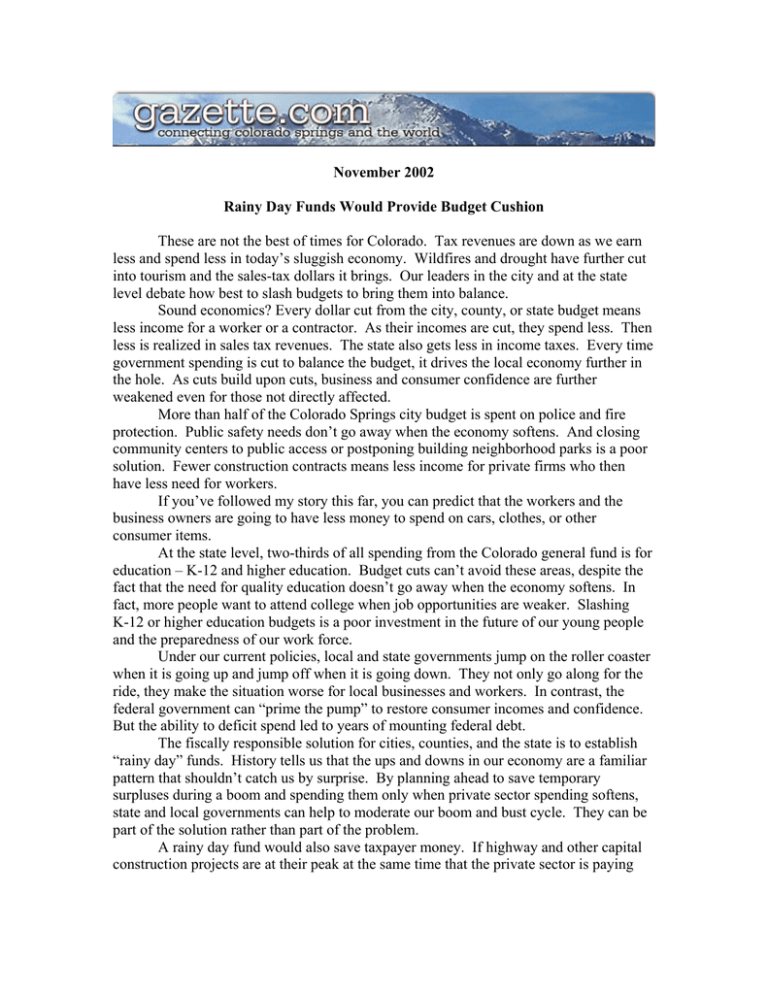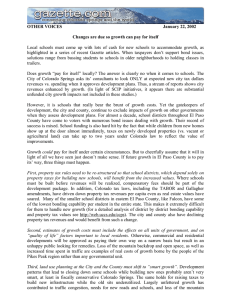November 2002 Rainy Day Funds Would Provide Budget Cushion
advertisement

November 2002 Rainy Day Funds Would Provide Budget Cushion These are not the best of times for Colorado. Tax revenues are down as we earn less and spend less in today’s sluggish economy. Wildfires and drought have further cut into tourism and the sales-tax dollars it brings. Our leaders in the city and at the state level debate how best to slash budgets to bring them into balance. Sound economics? Every dollar cut from the city, county, or state budget means less income for a worker or a contractor. As their incomes are cut, they spend less. Then less is realized in sales tax revenues. The state also gets less in income taxes. Every time government spending is cut to balance the budget, it drives the local economy further in the hole. As cuts build upon cuts, business and consumer confidence are further weakened even for those not directly affected. More than half of the Colorado Springs city budget is spent on police and fire protection. Public safety needs don’t go away when the economy softens. And closing community centers to public access or postponing building neighborhood parks is a poor solution. Fewer construction contracts means less income for private firms who then have less need for workers. If you’ve followed my story this far, you can predict that the workers and the business owners are going to have less money to spend on cars, clothes, or other consumer items. At the state level, two-thirds of all spending from the Colorado general fund is for education – K-12 and higher education. Budget cuts can’t avoid these areas, despite the fact that the need for quality education doesn’t go away when the economy softens. In fact, more people want to attend college when job opportunities are weaker. Slashing K-12 or higher education budgets is a poor investment in the future of our young people and the preparedness of our work force. Under our current policies, local and state governments jump on the roller coaster when it is going up and jump off when it is going down. They not only go along for the ride, they make the situation worse for local businesses and workers. In contrast, the federal government can “prime the pump” to restore consumer incomes and confidence. But the ability to deficit spend led to years of mounting federal debt. The fiscally responsible solution for cities, counties, and the state is to establish “rainy day” funds. History tells us that the ups and downs in our economy are a familiar pattern that shouldn’t catch us by surprise. By planning ahead to save temporary surpluses during a boom and spending them only when private sector spending softens, state and local governments can help to moderate our boom and bust cycle. They can be part of the solution rather than part of the problem. A rainy day fund would also save taxpayer money. If highway and other capital construction projects are at their peak at the same time that the private sector is paying top dollar to get work done, it costs us more. These same projects could be done for less in downturns, saving taxpayer dollars. Over the past 10 years, more than $2 billion in refunds, tax credits and tax cuts can be attributed to state government alone. If just half of that had been put in a rainy day fund, the $388 million which our legislature is slated to cut in January (on top of last year’s cuts of more than half a billion) would be no problem to cover. Right here at home, the Colorado Springs City Council cut property taxes every time booming sales tax revenues put us over the TABOR revenue limit. Since property taxes are more stable than sales taxes they can be a cushion in down years. But with property tax dollars comprising 8 percent a decade ago, the cushion has been worn too thin to help us much now. Governments need to plan ahead, realizing that good times don’t last forever. And they can only do this if citizens support wise budgeting by foregoing either tax cuts or new spending increases during the good times; if they call for the establishment of rainy day funds. Daphne Greenwood is professor of economics and director of the Center for Colorado Policy Studies at CU-Colorado Springs.


